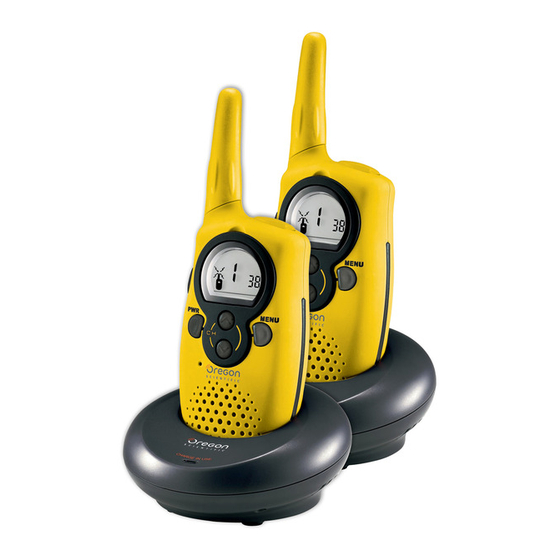
Table of Contents
Advertisement
Advertisement
Table of Contents

Summary of Contents for Oregon Scientific TP380
- Page 1 Model: TP380 User Manual...
- Page 2 MODEL: TP380 USER MANUAL INTRODUCTION Thank you for selecting the Oregon Scientific™ TP380 as your product of choice. This product is a portable, easy-to-use two-way radio transceiver that you can use to contact your family and friends at shopping centers,...
- Page 3 KEY FEATURES FRONT VIEW DESCRIPTION FUNCTION Antenna Flexible, bendable antenna receives and transmits signals, reduces chance of breakage and fits more easily and comfortably into shirt or pants pocket Display screen 1. Push to talk 2. Press PTT twice to enable Call Tone function 3.
-
Page 4: Back View
MENU 1. Scroll through menu options 2. Press and hold MENU to enable monitoring function 1. Increase Volume 2. Select Channel, CTCSS in MENU mode 1. Decrease Volume 2. Select Channel, CTCSS in MENU mode Speaker Receives voices / sounds from incoming call BACK VIEW DESCRIPTION FUNCTION... -
Page 5: Lcd Display Symbols
LCD DISPLAY SYMBOLS SYMBOL FUNCTION Receiving Transmitting Volume Voice Activation System Key Lock Auto Power Off Key Beeps Roger Beeps Scan Channel or CTCSS Battery Indicator Silent Alert function quietly alerts you of any incoming calls without beeping noises Channel Number: Select between 40 channels (big) CTCSS code: Adjust From 01-38 code (small) -
Page 6: Caring For This Product
SAFETY AND CARE INSTRUCTIONS SAFETY PRECAUTIONS Please observe the following safety precautions when setting up and using this product. * LCD panel – The LCD panel is made of glass, and may break if the unit is dropped or impacted. * Heat sources –... -
Page 7: Operating The Transceiver
OPERATING THE TRANSCEIVER 1. To access the battery compartment, slide the hook at the back of the transceiver in an upward motion and remove. 2. Slide the back cover of the transceiver in a downward motion to remove. 3. Insert 3 AAA batteries into the battery compartment, noting polarities. 4. -
Page 8: Basic Functions
5. Press and hold to turn on the device. The unit will beep with the LCD displaying all symbols for 1 second. 6. Use to increase or decrease volume, respectively. The VOL number will show on the LCD accordingly. 7. To turn the device off, press and hold until the unit beeps and the LCD goes blank. -
Page 9: Call Function
NOTE: 1. Use 3 AAA alkaline or rechargeable batteries when operating this unit. Before charging, study the user manual section on “Charging Contacts” for further instructions. 2. Reset: At any time if the unit can’t work properly, please take off the batteries and insert them again. TALKING INTO TRANSCEIVER 1. - Page 10 AUTO-SQUELCH FUNCTION Your transceiver has an Auto-Squelch function for hearing weaker, distant transmissions. You will not hear anything on a channel unless someone is transmitting nearby on the same channel. 1. Press and hold MENU for 2 seconds to enable/disable this function. 2.
-
Page 11: Selecting A Channel
Roger Beep Enable/disable beep heard after the finish of a received transmission Key Tone Enable/disable beep when a key on the transceiver is pressed Vibrating Enable/disable vibration function Automatic Enable/disable automatic shut-off after Power-Off device is idle for 2 hours NOTE: Press MENU to confirm and move to the next setting. - Page 12 2. Press and hold to begin scanning a CTCSS channel. If a valid signal is present, the transceiver will pause on the current active channel. 3. Press PTT to set and store the CTCSS channel, or the transceiver stores the display setting after 15 seconds. The scan mode will immediately search for the next CTCSS channel if no button is pressed after 5 seconds.
- Page 13 Normal sensitivity – ideal setting for voice- activated transmission High sensitivity – all detected sounds (including noise) are transmitted Low sensitivity – only audibly loud baby voices are transmitted (useful for noisy environments) Normal sensitivity – ideal setting for voice- activated transmission High sensitivity –...
-
Page 14: Silent Alert
1. Press MENU 5 consecutive times until appears on the LCD. 2. Press to activate/deactivate the Key Tone function. SILENT ALERT Enabling the Silent Alert function allows you to be aware of any incoming calls without needing to turn on any beeping sounds. 1. -
Page 15: Charging Contacts
ACCESSORIES CHARGING CONTACTS Your TP380 transceiver comes with 2 individual drop-in chargers that allow you to charge 2 transceivers at the same time using a connector cable and 1 adaptor, You may also charge each transceiver separately by an additional charger that comes with the package. -
Page 16: Channel Frequencies
CAUTION: 1. Located inside the transceiver’s battery compartment is a charging switch, which must be set to “ON” while charging. If alkaline batteries are used, switch the set to “OFF”. To avoid risk of fire or inquiry, do not switch to ON when using alkaline batteries. Directly charge Ni-MH rechargeable batteries by using an optional 1-bay cradle charger. - Page 17 476.675 477.175 476.700 477.200 476.725 477.225 476.750 477.250 476.775 477.275 476.800 477.300 476.825 477.325 476.850 477.350 476.875 477.375 476.900 477.400 CTCSS PRIVACY CODES CHANNEL FREQUENCY CHANNEL FREQUENCY (IN HZ) (IN HZ) 67.0 131.8 71.9 136.5 74.4 141.3 77.0 146.2 79.7 151.4 82.5 156.7...
-
Page 18: Specifications
114.8 225.7 118.8 233.6 123.0 241.8 127.3 250.3 SPECIFICATIONS RX Frequency 476.425 - 477.400 MHz Channels Modulation type Antenna impedance 50 Ohm Microphone condenser type Power supply 3 × AAA Alkaline Sensitivity at 12dB Sinad 0.5mV Adjacent Channel Rejection 55dB Audio Squelch Auto Audio output power... -
Page 19: About Oregon Scientific
We hope you will find all the information you need on our website, however if you'd like to contact the Oregon Scientific Customer Care department directly, please visit www2.oregonscientific.com/service/ support or call 949-608-2848 in the US. For international enquiries,...

Need help?
Do you have a question about the TP380 and is the answer not in the manual?
Questions and answers